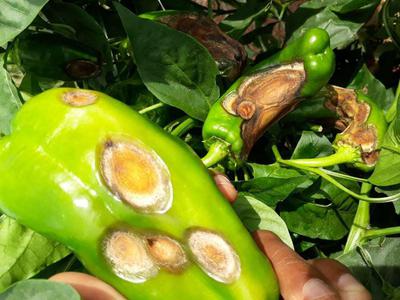Anthracnose of Pepper
Colletotrichum sp.
Fungus
In a Nutshell
- Fruit lesions.
- Grey-brown spots with dark brown edges on leaves and stem.
- Concentric rings within the fruit spots.
- Die back of branches and rotting of fruits.
Can also be found in
Symptoms
Water-soaked circular or angular lesions on fruits that later become soft and slightly sunken. The centers of the lesions are either orange or brown and turn black in color while the tissue nearby is lighter-colored. The lesions can cover most of the fruit surface. Multiple lesions occur. Concentric rings are common within the fruit spots. Green fruits may be infected but do not show any symptoms until they ripen. Foliage and stem symptoms appear as small, irregularly shaped gray-brown spots with dark brown edges. Late in the season, ripe fruit rot and die back of branches.
Recommendations

Organic Control
Infested seeds can be treated by soaking in 52°C hot water for 30 minutes. Temperature and time should be complied precisely to ensure the desired effect of the treatment.

Chemical Control
Always consider an integrated approach with preventive measures together with biological treatments if available. If fungicides are needed, spray products containing mancozeb or copper-based products. Start the treatment at flowering.
What caused it?
The disease is caused by a group of fungi of the genus Colletotrichum, among others C. gloeosporioides and C. capsici. These pathogens can infect pepper plants at all growth stages, on immature as well as on mature fruit, and post harvest. They survive in and on seeds, in plant debris or alternative hosts like Solanaceae. They can also be introduced anew by infected transplants. The fungi thrives during warm and wet periods, and can spread via rain or irrigation water. A fruit infection can occur at temperatures from 10°C to 30°C, while 23°C to 27°C is optimal for disease development. Fruit surface wetness increases the severity of the anthracnose.
Preventive Measures
- Apply manure to the soil to increase its carbon content before planting.
- Plan a good drainage of the field to avoid water logging.
- Apply mulch between the row to avoid the transmission of spores between soil and plants.
- Grow resistant varieties if available in your area.
- Use seeds from healthy plants or from certified sources.
- Check seedlings for signs of the disease before planting.
- Monitor field regularly for signs of the disease.
- Remove weeds and alternative hosts in and around the field.
- Avoid overhead irrigation and irrigate during mornings only.
- Plan a balanced fertilization of the field, using split nitrogen applications.
- Remove or destroy plant waste by burning after harvest.
- Rotate crops but not with other crops of pepper, tomato or strawberry.



